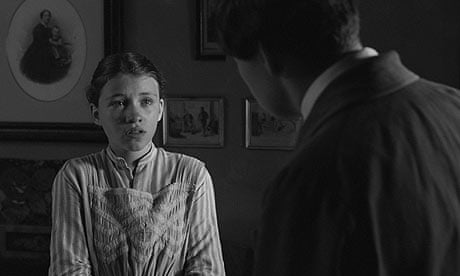The White Ribbon is a ghost story without a ghost, a whodunnit without a denouement, a historical parable without a lesson, and for two and a half hours, this unforgettably disturbing and mysterious film leads its viewers alongside an abyss of anxiety.
It has chilling brilliance and icy exactitude, filmed in black and white with the lustre of liquid nitrogen, and its director, Michael Haneke, achieves a new refinement of mastery and audacity. He has created a film whose superb technical finish and closure seems to me in contrast to its status as an "open" text, a work which resists clear interpretation. It reminded me of the group-guilt dramas of Friedrich Dürrenmatt and Max Frisch, and also the 1980 novel Wie Deutsch Ist Es? by Walter Abish, in which the son of a 1944 anti-Hitler plotter, who has just testified against a gang of fellow terrorists, returns to West Germany from France in the 1970s and asks himself how much of his homeland is in his soul. How German is it? Applied to The White Ribbon, the answer to this question can only be: very, very German indeed.
The setting is a remote village in northern Germany, in 1913, an outwardly placid but actually dysfunctional and repressive society, plagued with anonymous, retaliatory acts of malice and spite. The local doctor (Rainer Bock), out riding one day, is painfully thrown from his horse because a trip-wire was strung between two trees, and steathily removed by unseen hands after the incident. The infant son of the local Baron (Ulrich Tukur) is abducted and later found in a local woodland, badly beaten with a cane. A boy with Down's syndrome is similarly assaulted and almost blinded. In addition to these unsolved crimes, there are, enigmatically, others with perpetrators whose guilt is plain, such as the destruction of a cabbage crop by an embittered farmhand.
The movie is narrated in voiceover by the local teacher (Christian Friedel), now an old man, who explicitly announces that these painful events "could perhaps clarify some things that happened in this country". Could they? And what is the narrator's motive in remembering or misremembering these events? Could it be that, having presumably lived through both world wars, and very possibly achieved an important social standing in Germany, his own hindsight is questionable?
At the heart of everything is the pastor – an outstanding performance from Burghart Klaussner. He is a severe disciplinarian who rules his household with a rod of iron and insists on his family tradition of the "white ribbon" for wrongdoers, symbolising purity. His errant children have to wear the humiliating white ribbon tied around their arm until their father is convinced they are cleansed. The white ribbon could be the ancestor of the Jewish yellow star, or the Nazi armband. Or both. Or neither.
Haneke establishes a web of motive, and moreover suggests the ways in which the victims of some punishment could be displacing revenge on to people easier to attack than their actual tormentors. A group of local children, who appear to go around together in unwholesome intimacy like the blond devils in The Village of the Damned, could be the culprits. Yet there are others with grievances. The midwife and mother of the child with Down's syndrome, played by Susanne Lothar, is having an unhappy affair with the doctor, who treats her cruelly, and she further has evidence that he is abusing his 14-year-old daughter Anna. The scene in which Anna's tiny brother, wandering the house wakefully in the middle of the night, stumbles upon his father and sister together, is a masterpiece of ambiguous horror.
This is a place in which secrets can be kept for ever, revealing themselves only indirectly, in sociopathic symptoms. When war arrives in 1914, it is almost a relief: a sweeping away of all these festering resentments – like smashing the window in a stifling sick-room. Haneke is however also suggesting that Germany's 20th-century wars are merely a continuation of this sickness on a bigger scale, though the link can never be clearly, definitively made. His villagers are convulsed by an enemy within, and although the Baron employs a number of Polish estate workers, there is no quasi-Jewish outsider upon whom the community focuses its fear.
Within this puzzle, Haneke constructs scenes and sequences that are instant classics. The schoolmaster is conducting a delicate courtship of a local young woman, and despite Haneke's reputation for darkness, this plot-strand is gentle, touching and humorous – difficult though that may be to believe. Anna's little brother has the existence of death explained to him, and the result is funny and shocking at once, and the same goes for the sub-plot that follows from the pastor's little son asking if he can keep a caged bird, like the one his father has, and the consequence is both unsettling and poignant.
In the end, there is no solution to the mystery; it could be that history and human agency are unknowable, untreatable, or it could be that the Nazi generation grew up with unexpired resentment and the frustration of not getting a solution – and the director wishes us to hear the malign echoes of that word. This is a profoundly disquieting movie, superbly acted and directed. Its sinister riddle glitters more fiercely each time I watch it.



